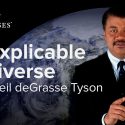For the uninitiated
The people’s astrophysicist Neil DeGrasse Tyson, Ph.D hosts the six-part miniseries Netflix production that expounds on how the latest in cutting-edge technology helps scientists probe deeper than ever before into both the interstellar and quantum cosmos.
Now that you’re caught up
It’s rare when starting a science lecture, especially at the scale this production was made for, to do so without some kind of historical recap. In History’s Mysteries Dr. Tyson opens the segment with a very profound remark about how we as a species have come to learn so much about the way the universe works, and yet while the body of our understanding of the universe is impressive it does also pale (pathetically) against how much there is still yet to learn. This mini-series provides a thorough and comprehensive look at both quantum and celestial mechanics through the ages of mankind, from pre-scientific era (before Galileo) to modern times in the conjecture of the multi-verse.
Some of my own favorite segments from the series –yes, spoilers are now coming– was in episode 3 Inexplicable Life when Tyson expounds on the theory of Panspermia, which is that the building blocks for life as we know it didn’t start on Earth, but from elsewhere in the universe -in this case Mars- and seeded life on Earth likely by way of meteor strike from Mars to Earth during the ladder end of the Heavy Bombardment period. Just to keep you readers up to speed: the heavy bombardment period is very much like it sounds – when there were still so many asteroids and other disorganized celestial bodies figuring out their place in the solar system that they slammed into Earth often enough that life couldn’t get started because the Earth was still too hot.
Another of my favorite segments in the series was episode five Inexplicable Space where Tyson talks about dark matter, which, as he puts it, accounts for the origin of 85% of the gravity in our universe. Unfortunately we still know so little about the stuff. Our most precise instruments really can’t even detect the stuff. It doesn’t make a noticeable interaction with either light or matter the way we know it (baryonic matter). Tyson posits three ideas as the origin of dark matter, but his and my favorite of the ideas of what dark matter is goes back to my favorite realm of science fiction: the multiverse. Both Dr. T and myself think that dark matter may well be the ordinary matter of an even bigger parallel universe that, through gravity leakage, is spilling over into ours; and if that is true it will of course mean that the theory of parallel universes has been right all along!
What sets this mini apart from other documentaries on Netflix is that this has no pseudo-science attached. As any Netflix subscriber can attest the Doc & Reality TV category is wrought with “documentaries” like The Pyramid Code and UNSEALED – Alien Files and a smorgasbord of conspiracy theory shows. Those shows are all good where having fun around the campfire is concerned, but not so much for those of us with a real curiosity for physics and chemistry and biology. Dr. Tyson keeps the process of learning, whether by exposing his audience to new information or merely re-affirming what some of us may have remembered from our primary school days, fun and exciting. Following closely in the footsteps of his mentor, Dr. Carl Sagan (1936 – 1994), Tyson makes a concerted effort to keep his audience engaged and, if you’re me, frothing at the mouth for more!






